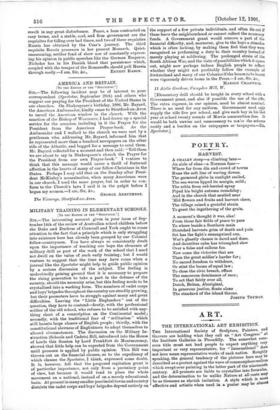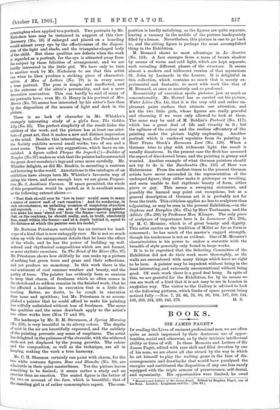ART.
THE INTERNATIONAL ART EXHIBITION. THE International Society of Sculptors, Painters, and Gravers are holding what they call an "Art Congress" at the Institute Galleries in Piccadilly. The somewhat sono- rous title must not lead people to expect anything very important or very representative, for " international " does not here mean representative works of each nation. Roughly speaking, the general tendency of the pictures here may be described as a protest against the wave of commonplace realism which swept over painting in the latter part of the nineteenth century. All protests are liable to crystallise into formulas, and the determination to be unlike Nature at all costs may be as tiresome as slavish imitation. A style which is most effective and artistic when used in a poster may be almost
meaningless when applied to a portrait. Two portraits by Mr.
Nicholson here may be instanced in support of this view. Boalliegry (No. 18) if enlarged and placed on a hoarding
would attract every eye by the effectiveness of the disposi- tion of the light and shade, and the triangular-shaped body
of the child. But these qualities are defects when the work is regarded as a portrait, for the eye is attracted away from
the subject by these felicities of arrangement, and we are
hardly interested in the little girL We have only to turn to another work by Mr. Nicholson to see that this artist
Can when he likes produce a striking piece of characteri-
sation. A Man of Letters (No. 79) is in every sense a true portrait. The pose is simple and unaffected, and
is the outcome of the sitter's personality, and not a mere decorative convention. This can hardly be said of many of the portraits here ; even Mr. G. Henry in his portrait of Mrs. Morris (No. 76) seems less interested by his sitter's face than by the disposition of the masses of light and dark in the picture.
There is no lack of character in Mr. Whistler's strangely interesting study of a girl's face, The Golden Lily (No. 35). The perfect simplicity of the result hides the subtlety of the work, and the picture has at least one attri- bute of great art, that it makes a new and distinct impression on the mind. Besides this interesting head, the President of the Society exhibits several small works, two of sea and a street scene. These are airy suggestions, which leave us un- satisfied. A figure called Phryru3 the Superb (!)—Builder of Temples (No. 37) makes us wish that the painter had constructed the great demi-mondaine's legs and arms more carefully. Mr.
Whistler delights, as did Mr. Ruskin, in mounting a rostrum and lecturing to the world. Annotations to the catalogue of an exhibition have always been Mr. Whistler's favourite way of
airing his views, and sure enough here we are given .Proposi- tion No. 2, Acadgmie Carmen. If space permitted, the whole
of this proposition would be quoted, as it is excellent sense, as the following extract shows :--
" That flesh should ever be low in tone' would seem to many a source of sorrow and of vast vexation ! And its rendering, in such circumstance, an unfailing occasion of suspicious objection and reproach. The one aim of the unsuspecting painter is to make his man 'stand out' from the frame—never doubting that, on the contrary, he should really, and, in truth, absolutely does, stand within the frame—and at a depth behind it, equal to the distance at which the painter sees hie model."
Mr. Bertram Priestman certainly has an instinct for land- scape of a kind that is now unhappily rare. He is not so much taken up with the unimportant details that he loses the effect of the whole, and he has the power of building up well- ordered and rhythmical compositions which are not formal, or mere stylistic exercises. In The Bend of the River (No. 87) Mr. Priestman shows how skilfully he can make up a picture of nothing but green trees and grass and their reflections, and yet produce no monotony. In this work there is the real sentiment of cool summer weather and beauty, and the poetry of trees. The painter has evidently been so anxious to keep that charm of freshness which so often comes in the sketch and so seldom remains in the finished work, that he has affected a hastiness in execution that is a little dis- tracting. Better, no doubt, to be rough in execution than tame and spiritless; but Mr. Priestman is so accom- plished a painter that he could afford to make his painting less wilfully unfinished without loss of freshness. The same fine qualities and the same drawback apply to the artist's two other works here (Nos. 77 and 89).
The landscape by Mr. R. M. Stevenson, A Spring Morning (No. 258), is very beautiful in its silvery colour. The depths
of mist in the air are beautifully expressed, and the subtlety of the painting prevents any sense of emptiness. The artist has delighted in the paleness of the riverside, with the withered reeds not yet displaced by the young growths. The colour and the composition, as well as the technique, are all in keeping, making the work a true harmony.
Mr. C. H. Shannon certainly can paint with charm, for the two white costume figures, Rose and Blanche (No. are admirable in their quiet masterliness. Yet the picture leaves
something to be desired ; it seems rather a study and an exercise than an emotion. The seated figure is the'better of the two on account of the face, which is beautiful ; that of the standing girl is of rather commonplace aspect. The com-
position is hardly satisfying, as the figures are quite separate, leaving a vacancy in the middle of the picture inadequately filled by a lemon. Nevertheless, this picture is one to go back to, and the sitting figure is perhaps the most accomplished thing in the Exhibition.
M. Besnard shows to most advantage in Le Sourire (No. 124). A face emerges from a mass of brown shadow by means of warm and cold light, which are kept separate, each revealing different planes of the structure. It seems almost a modern and iridescent version of that mysterious St. John by Leonardo in the Louvre. It is delightful in this collection, which contains so much that is merely ex- perimental and fantastic, to meet with work like that of M. Besnard, at once so masterly and so profound.
Eccentricity of execution spoils pictures just as much as conventionality. Mr. Hornel has so carried out his picture, Water Lilies (No. 14), that it is the very odd and rather un- pleasant paint surface that attracts our attention, and not the two little girls, whose figures are really graceful and charming if we were only allowed to look at them. The same may be said of M. Boldini's Portrait (No. 117), which has a great deal of life and vivacity in it ; but the ugliness of the colour and the restless effrontery of the painting make the picture highly unpleasing. Another portrait which is rendered repulsive from its painting is Herr Franz Stuck's Hermann Levi (No. 128). When a German tries to play with iridescent light the result is usually disastrous. In the present case the flesh has assumed the aspect of discoloured brass, and the painting is greasy and worried. Another example of what German painters should not try to do is the Bacchantin (No. 153) of Herr von Haberman. From the earliest times to the present German artists have never succeeded in the representation of the undraped figure; they either make it grotesque or revolting, and seem unable to feel rhythmic beauty of form, either grave or gay. This seems a sweeping statement, and possibly the learned may point out exceptions, but as a general description of German art it is probably not far from the truth. This criticism applies no less to sculpture than to:painting, as may be seen in the present Exhibition,—in the Orpheus and Eurydice (No. 67s) by Herr Taubman, and the Athlete (No. 296) by Professor Max Klinger. The only piece of sculpture of importance here is Le Lamineur (No. 294), by M. C. Meunier, which is of great beauty and dignity. This artist carries on the tradition of Millet as far as form is concerned ; he has much of the master's rugged strength, though his tenderness is not so evident. One of M. Meunier's characteristics is his power to endow a statuette with the breadth of style generally only found in large works.
It is to be regretted that the Selecting Committee of the Exhibition did not do their work more thoroughly, as the walls are encumbered with many things which have no right to be here. A painter may be impudent without being in the least interesting, and extremely unconventional without being good. Of such work there is a good deal hung. In spite of this, we are grateful for the Exhibition, for by its means we can see work of a kind that it is not easy to see in London in anyjother way. The visitor to the Gallery is advised to look at the following pictures, which limits of space prevent being noticed fully :—Nos. 7, 23, 66, 78, 80, 96, 104, 107, 109, 144,















































 Previous page
Previous page